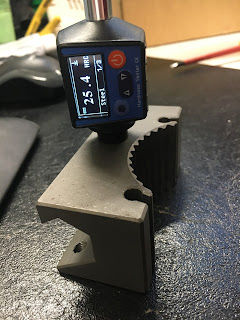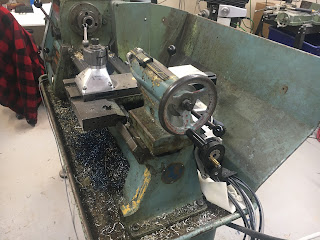Colchester splines
Having turned up and threaded the body for the extension piece with undue cockup, I need to spline the thing so that the handwheel will fit on it. The scheme used on the Colchester lathes has 6 splines, with parallel faces on each side of the raised spline section. Words don't describe that easily but a sketch view does a good job.
This is the same spline standard used on the change gears on the screwcutting drive train - I came across this when I made my still-born single tooth screwcutting clutch, which was an adaptation of Graham Meek's concept. I milled these manually back then and it didn't seem to be very difficult once it was all measured up carefully.
Here's what it looks like:
It's fairly easy to create this in a sketch, then create a circular pattern:
How to machine this?
At this point I could go mental and try to generate a fancy curved (cylindrical) surface between the splines using some sort of simultaneous 4th axis moves. Or I could if that toolpath were available in my version of Fusion. Which it isn't, as I can't justify spending £200/month on those blasted "extensions" of theirs.
Instead I will use indexed ("wrapped") toolpaths to do the job. There's no problem taking more material off than strictly required if that makes the job easier / possible.
My plan is fairly simple. Using a 4mm end mill (which is spot on for the gap between splines), I will machine one side of a spine tooth...
....then the other side....
....then remove the material between the troughs created:
The overall collection of toolpaths looks like this:
Chip time:
I've finessed the feeds and speeds, set the heights, checked for unauthorised moves and looked for any other gotchas. Now the time has come to stop fannying about and cut the fucker.
I currently have a Tool 8 which is a 4mm 3 flute carbide end mill but technically it's an uncoated (ie loominum cutting) tool. However, I'm talking low carbon, mild steel here and will be taking light cuts (10um per tooth) with a shallow depth of cut (just over 1mm), so I doubt it's an issue. Besides, it's a Chinesium cutter from Yuze Tools, so it didn't cost a whole bundle and this is a good chance to try them out on steel for the first time.
Perhaps a cleanup might be in order before I get machining? Poor thing has been buried under a load or loominum and polycarbonate swarf. That won't do.
Off we go:
The WCS origin for this setup is on the end face of the splines, on the stock axis - for 4th axis work it certainly needs to be on the axis of rotation. I can probe the diameter and end face easily enough in X and Y with the Renishaw probe, then pick up the outer diameter of the stock to determine / set the Z axis position.
That worked out nicely. The runout is about 2''' on the "Kurt" DTI - that's about 50um which is pretty good for the 3 jaw chuck in my 4th axis and for what I'm doing here it's more than good enough. I'm fitting a handwheel on a shaft, FFS.
Right, enough dicking about. Z ref height set and tool length checked for Tool 8. Off we go - what go possibly go wrong etc etc.
And here's the video evidence:
I should have gone for the Youtube Warrior cunning stunt ie trying the handwheel live immediately after the machine had finished, 'cos it fitted straight on. Bloody hell. Here it is in its glory:
Alongside its predecessor:
Ready to go on the machine:
Well - does it fit, Fatty?
There's only one way to find out - and there's no time like the present. Here's the old, temporary assembly coming off:
I'll stash the old leadscrew and splined shaft in the cupboard along with the other manual controls I've removed. There may be some value in having all that shite if somebody takes this off my hands for another few decades when I'm done with it.
And here it is - and yes, it all works.
Bloody hell, I think we can call it there.

















































